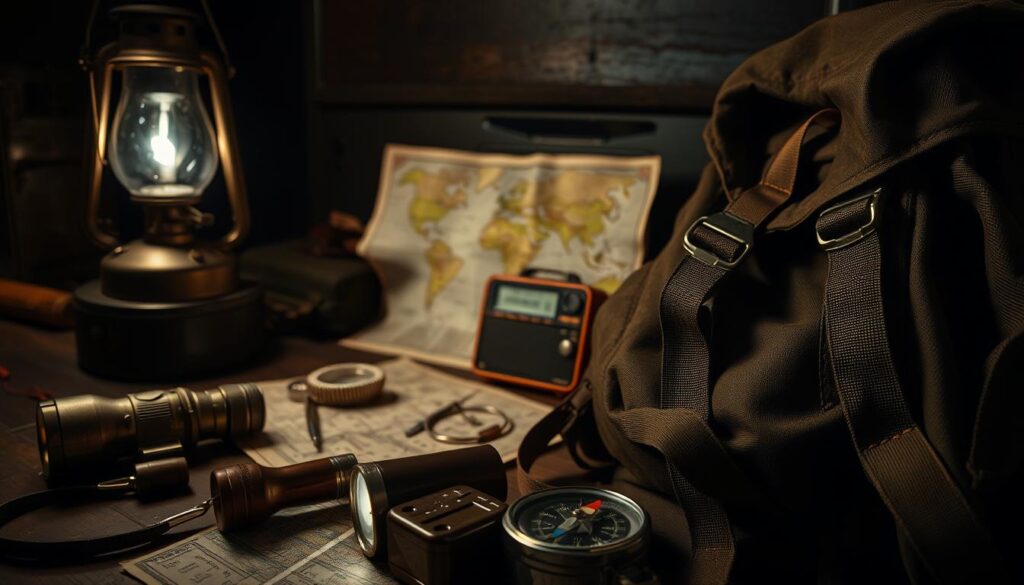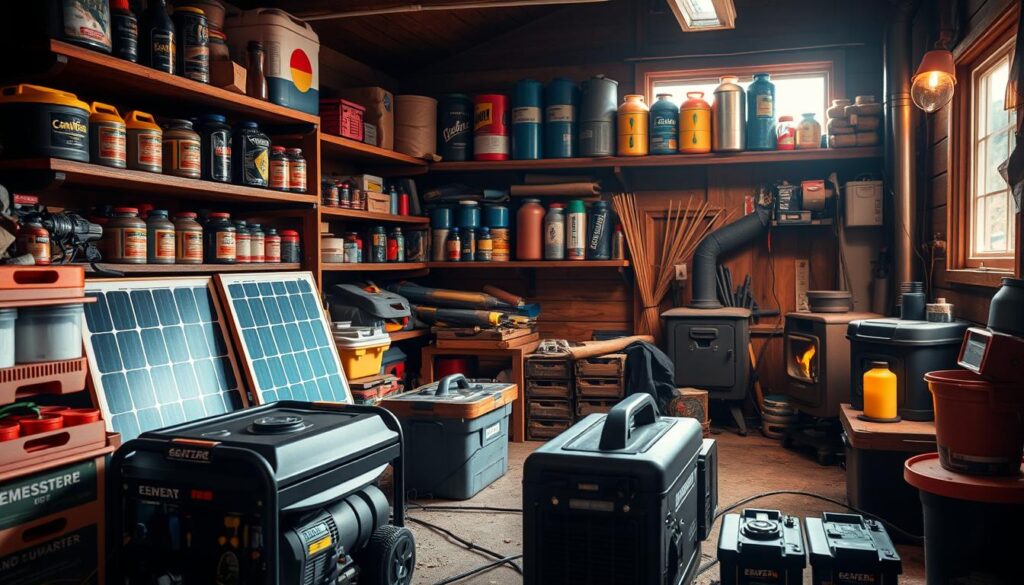Learning to start a fire is key for outdoor lovers. It’s vital whether you’re camping, hiking, or just enjoying nature. Knowing how to start a fire safely can save your life. It all starts with understanding the basics and practicing.
Having the right tools, like a fire starter kit or camping fire tools, is important. These tools help you cook, stay warm, and even signal for help. So, don’t underestimate the value of fire making essentials.
Key Takeaways
- Understanding the basics of fire starting techniques is key for outdoor survival.
- Having the right tools, such as a fire starter kit, is essential.
- Mastering fire making techniques requires practice and patience.
- Fire making essentials provide a means to cook food, stay warm, and signal for help.
- Being prepared with the right camping fire tools can make a big difference in outdoor experiences.
Understanding Fire Making Essentials
Learning how to make fire can save your life in survival situations. Fire gives us warmth, light, and a way to cook food. It’s key for surviving outdoors.
The Importance of Fire in Outdoor Survival
Fire is vital for outdoor survival. It keeps us warm, lights our way, and helps purify water. John ‘Lofty’ Wiseman, a top survival expert, said, “Fire is the most important survival tool”. This shows how important it is to know how to make fire.
Fire also has mental benefits. It can lift our spirits and give us comfort when we’re stressed.
Key Components of Fire-Making Equipment
To start a fire, you need tinder, kindling, and fuel. Tinder is dry, flammable stuff like leaves or grass. Kindling are sticks and twigs that burn after tinder ignites. Fuel are the big logs that keep the fire going.
- Tinder: Dry leaves, grass, or small twigs
- Kindling: Small sticks and branches
- Fuel: Larger logs
Having the right tools, like a good fire ignition tool (e.g., matches, lighters, or a flint and steel), is essential. What you choose depends on what you like, the place you’re in, and the situation.
Types of Fires and Their Uses
When you go into the wilderness, knowing about different fires is key. Fires help with warmth, cooking, and signaling for help. It’s important for a safe and fun trip.
Campfires versus emergency fires
Campfires are for fun, like camping or hiking. They help cook food, warm up, and socialize. Emergency fires, though, are for survival. They provide warmth, light, and a way to cook when you’re stranded.
Having a fire starter kit is useful for both. It makes starting a fire easy and reliable.
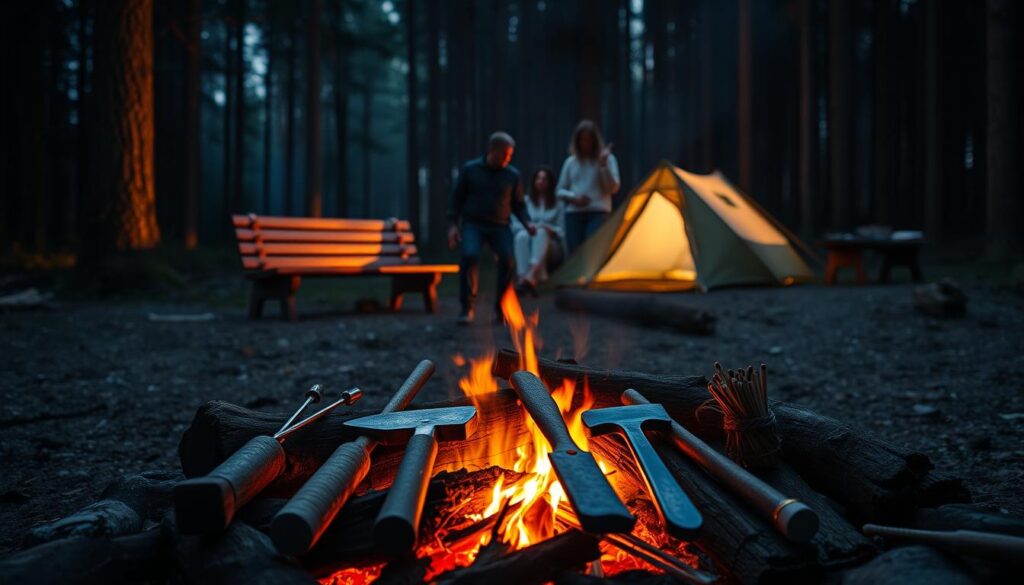
Signal fires for rescue situations
Signal fires help alert rescuers you’re there. They’re built high up or in open areas for better visibility. Dry tinder and kindling make a smoke-filled day fire and a big flame at night.
Adding waterproof matches to your kit helps start a fire even when it’s wet.
Cooking fires for outdoor meals
Cooking fires are vital for meals on outdoor trips. They need a steady flame. Using camping fire tools, like a portable grill, makes cooking better. It lets you safely and efficiently cook many meals.
Selecting the Right Location for a Fire
When you go into the wilderness, picking the right spot for a fire is key. It affects both safety and how well you can enjoy your time outdoors. I’ve spent a lot of time outside and know that a good fire spot is essential.
Safety considerations and fire regulations
Before you start a fire, know the local fire rules and any bans. Check if you need a fire permit and what the area’s fire rules are. Also, think about how close you are to things that can catch fire, like dry leaves or branches.
| Safety Consideration | Description |
|---|---|
| Proximity to flammable materials | Avoid areas with dry leaves, grass, or overhanging branches to minimize fire spread risk. |
| Local fire regulations | Understand burn bans, fire permits, and specific rules governing fire use in the area. |
| Overhead clearance | Ensure the area above the fire is clear of low-hanging branches or other combustible materials. |
Wind direction and proximity to resources
Wind direction is important when picking a fire spot. It affects the fire’s safety and how comfortable you’ll be. Also, being close to water, food, and firewood makes your outdoor adventure better. It saves you from having to go far for these things.
Thinking about these things helps make a fire that’s safe and works well. Using outdoor survival gear and fire ignition equipment like a windproof lighter makes starting a fire easier. It’s more reliable, no matter the weather.
Tools I Use for Fire Making
Over the years, I’ve learned that the key to successful fire making lies in the tools you use. Having the right equipment can make all the difference, whether you’re camping, hiking, or in a survival situation.
Traditional Methods: Flint and Steel
One of the most reliable traditional methods for fire making is using a flint and steel. This technique involves striking a piece of steel against a flint to generate sparks. It’s a skill that requires some practice, but once mastered, it’s very effective.
The flint and steel method is great in wet conditions because it can produce sparks even when the materials are damp. But, it does require some physical effort and technique.
Modern Tools: Lighters and Matches
In modern times, we have the convenience of lighters and waterproof matches. These tools are easy to use and highly effective, making them ideal for everyday carry.
Lighters are very user-friendly, as they require minimal effort to produce a flame. Waterproof matches, on the other hand, offer a more traditional feel while being reliable in various weather conditions.
Fire Starters: Natural and Manufactured Options
Besides flint and steel, there are other fire starters available, both natural and manufactured. Natural options include dry leaves, grass, and small twigs, which can be used as tinder.
Manufactured fire starters, such as fire starter kits, often contain materials like ferrocerium rods or magnesium strikers. These kits are designed to be compact and portable, making them excellent for outdoor adventures.
Here’s a comparison of the different fire making tools:
| Tool | Effectiveness | Reliability | Ease of Use |
|---|---|---|---|
| Flint and Steel | High | High | Moderate |
| Lighters | High | High | Easy |
| Waterproof Matches | High | High | Easy |
| Fire Starter Kits | High | High | Easy to Moderate |
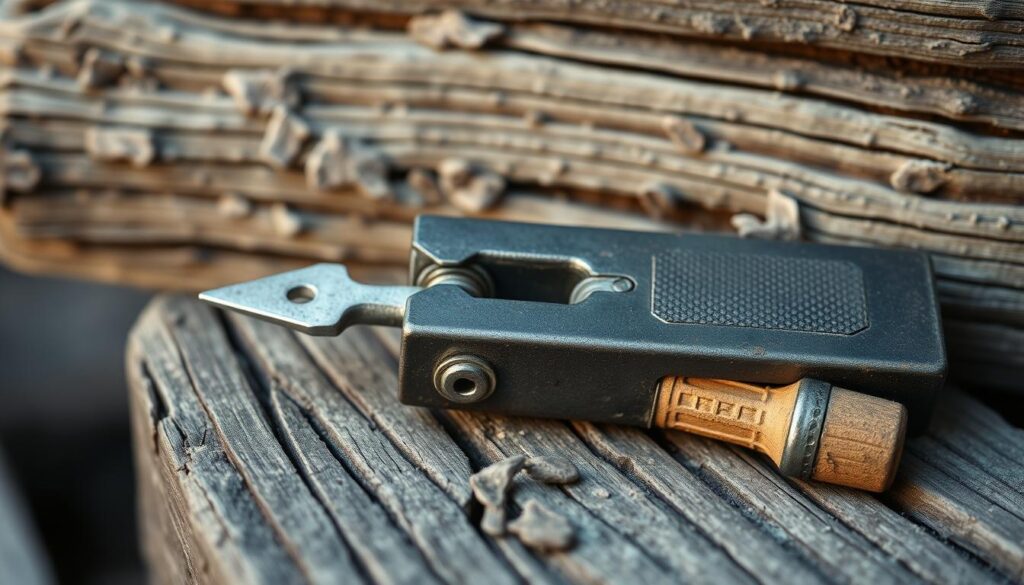
Gathering Fuel for Your Fire
Getting the right materials is key to starting and keeping a fire going. You need tinder, kindling, and logs for this. Each plays a special role in building your fire.
Building a Solid Foundation with Tinder
Tinder is the easiest to light and starts the fire. It’s made of dry, fluffy stuff like leaves, grass, or small twigs. Good tinder burns fast and lights easily.
Look for tinder that’s dry and brittle. This means it will light up quickly. Examples include dry moss, small sticks, and shredded bark.
Kindling: The Next Step in Fire Building
Kindling is bigger than tinder, about pencil size or a bit larger. It should also be dry and brittle. Kindling helps grow the fire started by tinder.
Arrange kindling in a teepee or crisscross pattern. This lets air flow well, helping the fire grow.
Logs and Larger Fuel Sources
When the fire is strong with kindling, add bigger logs. These logs should be dry and have a mix of hardwoods for a long burn. Softwoods are good for starting but not for long burns.
The size of logs depends on how big you want your fire and how long it should last. Always choose dry, dead wood for better burning.
Think about the environment and what’s available when gathering fuel. Adjust the size and type of fuel based on your fire’s needs. This could be for cooking, warmth, or signaling.
Effective Fire Combustion Techniques
The way a fire is built greatly affects how well it burns. There are many techniques to make a fire strong and stable. Knowing how to build a fire is key for outdoor adventures and camping.
The Teepee Structure for Strong Fires
The teepee structure is great for starting a fire fast. Begin by placing a small amount of tinder in the center. Next, arrange kindling sticks around it in a teepee shape, leaving space to light the tinder.
The Log Cabin Method for Stability
The log cabin method makes a fire stable and long-lasting. Start with tinder in the center, then add a square of kindling around it. As the fire grows, add logs to build a “cabin” structure.
This method is perfect for cooking and keeping warm for a long time.
The Mound Fire for Wind Resistance
The mound fire is great for windy conditions. Begin with tinder on the ground, then build a mound of kindling over it. This shape protects the fire from wind, making it burn better.
It’s a good choice for survival in windy areas.
| Fire Structure | Advantages | Best Use Cases |
|---|---|---|
| Teepee | Strong initial flame, easy to light | Starting a fire quickly, camping |
| Log Cabin | Stable, long-lasting fire | Cooking, extended warmth |
| Mound Fire | Wind resistance, protected flame | Outdoor survival in windy conditions |
Learning these fire techniques helps outdoor lovers have a reliable fire. This makes their camping or survival trips better.
The Role of Chemistry in Fire Making
Chemistry is key in making fire for outdoor survival. I’ve spent a lot of time in the wild. I know how important it is to understand the chemical steps to make and keep a fire.
Fire making isn’t just about sparking. It’s about the chemistry of burning. Knowing how combustion works helps make fires that keep us warm, light our way, and cook our food.
Understanding the Combustion Process
The combustion process is a chemical reaction. It happens when fuel and oxygen mix, releasing heat and light. This reaction is the heart of fire making. It’s shaped by the fuel type, oxygen availability, and the reaction temperature.
- The fuel source is what burns.
- Oxygen is key for the burn to keep going.
- Temperature controls how fast and well the burn happens.
How Oxygen Impacts Fire Efficiency
Oxygen is vital for a fire’s efficiency. Enough oxygen means the burn is complete, making it cleaner and more efficient. Without enough oxygen, the burn is incomplete, leading to smoke and less efficient fires.
To get the most out of your fire, make sure it has good airflow. You can do this by arranging the fuel right or using tools that help air flow.
- Stack your fuel in a teepee or log cabin shape for better airflow.
- Use bellows or blow on the fire to add oxygen when it’s needed.
Understanding fire making chemistry helps us make and keep fires in the outdoors. It’s key for survival gear and tools for starting fires.
Advanced Fire Making Techniques
Advanced fire making techniques are key for outdoor survival and self-reliance. They help you start fires in different conditions. These skills are vital in survival situations.
Bow Drill for Friction Fire
The bow drill is a traditional way to make fire through friction. It takes practice but works well. You need a bow, a drill, a fireboard, and a string to use it.
Here’s how to make a bow drill:
- Create a notch in the fireboard and place a small piece of tinder underneath.
- Loop the bowstring around the drill and secure it with the bow.
- Apply downward pressure on the drill while moving the bow back and forth to generate friction.
- Once an ember forms, gently blow on it to ignite the tinder.
Fire Plough Method
The fire plough method uses friction to create heat. You make a groove in wood and plough through it with a stick.
To use the fire plough method:
- Select a softwood base and create a groove in it.
- Use a hardwood stick to plough through the groove, applying significant pressure.
- Continue until you notice the formation of an ember.
- Nurture the ember into a flame by adding tinder.
Solar Fire Starting Techniques
Solar fire starting uses the sun’s energy to start fires. It’s great on sunny days.
To start a fire with solar power:
- Use a magnifying glass or a clear plastic water bottle to focus the sun’s rays onto a small area.
- Hold the focal point on a piece of tinder until it starts to smoke and eventually ignites.
For more on advanced fire starting, visit OffGridWeb’s guide on advanced fire starting in cold weather.
| Technique | Equipment Needed | Skill Level |
|---|---|---|
| Bow Drill | Bow, drill, fireboard, string | Advanced |
| Fire Plough | Softwood base, hardwood stick | Advanced |
| Solar Fire Starting | Magnifying glass or clear plastic | Intermediate |
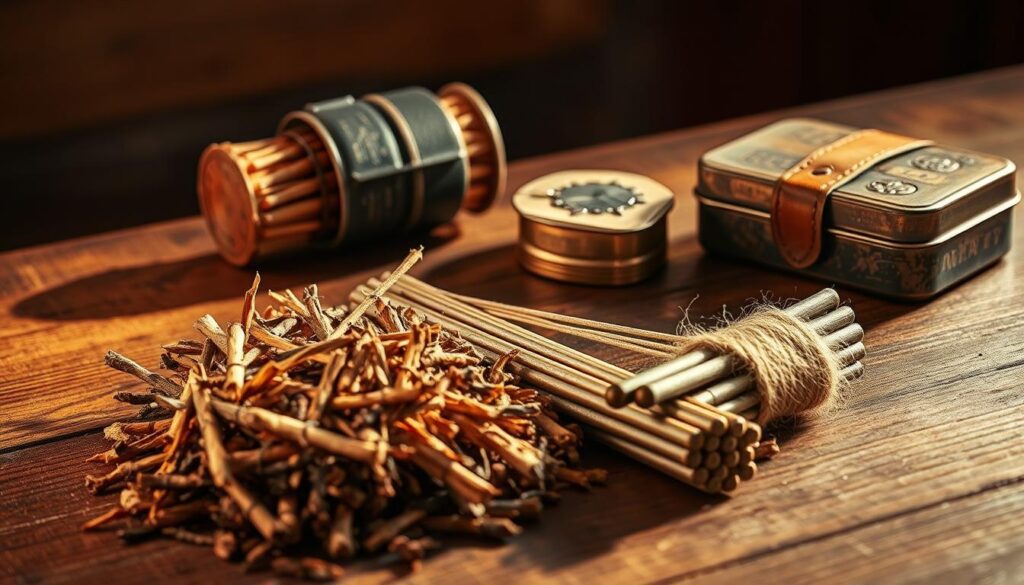
Learning these advanced fire making techniques boosts your outdoor survival skills. It also builds self-reliance. Whether using a fire starter kit or primitive methods, starting a fire is essential. Always think about the environment and safety when starting a fire. Make sure to fully extinguish it when done.
Recognizing Fire Hazards
Fire making can save lives, but it comes with risks. Before starting a fire, I must know the dangers. I need to take steps to avoid them.
Common mistakes that cause fires
Choosing the wrong spot for a fire is a big mistake. It can spread to nearby areas. I should pick a safe place, away from things that can catch fire.
Not preparing for weather changes is another error. Windy or dry weather can make a fire dangerous. I should check the weather first and be ready to stop the fire if needed.
Managing fire risks in windy conditions
In windy weather, I must be extra careful. Using a fire pit or a ring of rocks helps keep the fire in check. I also make sure to fully put out the fire before leaving it alone.
I pay attention to the wind direction too. I stand upwind of the fire to avoid sparks and embers. This keeps me and nearby flammable things safe.
| Risk Factor | Precaution |
|---|---|
| Windy Conditions | Use a fire pit or ring of rocks, monitor wind direction |
| Dry or Flammable Surroundings | Clear the area, have a fire extinguishing plan |
Extinguishing Your Fire Safely
Knowing how to put out a fire is as important as starting one. When camping or in survival situations, it’s key to safely extinguish fires. This prevents wildfires and accidents.
When to Extinguish a Fire
It’s vital to put out a fire when it’s no longer needed. This could be at the end of a camping trip or when leaving a campsite. If there are fire restrictions, it’s important to follow them to prevent wildfires.
- When you’re done using the fire for cooking or warmth.
- Before leaving your campsite or outdoor area.
- If you notice changing weather conditions that could spread the fire.
Techniques for Effective Dousing
To extinguish a fire safely, you need the right techniques. This ensures the fire is fully out, requiring careful attention.
Here are some steps to follow:
- Stop adding fuel to the fire.
- Douse the fire with water, if available. For a campfire, pour water over the flames, then stir the ashes to ensure everything is extinguished.
- If water is scarce, use dirt or sand to smother the fire, though this method is less effective than water.
- Check the fire pit or area for any remaining heat or embers. If you’re using a fire starter kit or camping fire tools, make sure you have a way to monitor the fire’s status.
- Repeat the dousing and stirring process until the fire is out and the area is cool to the touch.
Using the right outdoor survival gear helps manage and extinguish fires. Make sure you have the tools and knowledge to handle fire safely.
Practical Applications of Fire Making Skills
Learning how to make fire is key for camping, hiking, and survival. Fire making skills are useful for many things. They make outdoor adventures better and are vital in survival situations.
When it comes to outdoor survival gear, knowing how to make fire is basic. It gives warmth, light, and lets people cook food and purify water. It also helps in signaling for help when needed.
Camping and Hiking Excursions
For those who camp and hike, fire making is a must. It makes their outdoor time better. It lets them enjoy hot meals, stay warm, and create a cozy atmosphere at their campsite.
- Having a good way to start a fire makes camping or hiking smoother.
- Fire making skills can lift spirits, giving a sense of safety and comfort in the wild.
Survival Scenarios and Wilderness Training
In survival situations, making fire can save lives. It’s a way to start a fire without modern tools. This skill is essential for wilderness survival and being ready for emergencies.
Knowing how to use emergency fire supplies and fire ignition equipment is key in survival. It can make a big difference in such situations.
Resources for Further Learning
I’ve put together a list of valuable resources to help you improve your fire making and outdoor survival skills. Whether you’re just starting out or have lots of experience, these tools will help you get better. They also ensure you stay safe in the wilderness.
Recommended Reading
If you want to learn more about survival skills, check out some books. They cover topics like fire making, building shelters, and navigating outdoors. These books offer detailed guides and expert tips on the best gear, including fire starter kits and camping tools.
Online Courses and Tutorials
Online courses and video tutorials are great for learning new skills. Many websites have classes on wilderness survival, outdoor skills, and being ready for emergencies. They often show how to use survival gear and camping tools.
FAQ
What are the essential tools for fire making?
Essential tools for fire making include flint and steel, lighters, and waterproof matches. You should also have various fire starters. Carry a fire starter kit with these items to be ready for any situation.
How do I choose a safe location for a fire?
Choose a safe fire location by considering the environment and safety rules. Find a spot away from flammable materials and overhanging branches. Always check local fire laws to make sure it’s okay to have a fire there.
What are the different types of fires and their uses?
There are many types of fires. Campfires are for fun, emergency fires for warmth and light, and signal fires to alert others. Cooking fires are best for outdoor meals.
How do I build a fire that burns efficiently?
To build an efficient fire, gather the right fuel. Use tinder, kindling, and logs. Build a fire structure like a teepee or log cabin. Leave space in the center for air to help the fire breathe.
What are some advanced fire making techniques?
Advanced techniques include the bow drill, fire plough, and solar fire starting. These need practice but are useful in survival situations. Learn them through online courses or videos.
How do I extinguish a fire safely?
To safely put out a fire, fully douse it with water and stir the ashes. You can also use a fire extinguisher or smother it with dirt or sand. Always check that the fire is out before leaving it.
What are some common mistakes to avoid when making a fire?
Avoid mistakes like not preparing for wind, not having enough fuel, and not fully extinguishing the fire. Always be aware of your surroundings and take precautions.
Can I use a magnifying glass to start a fire?
Yes, you can start a fire with a magnifying glass by focusing the sun’s rays. This works well in sunny weather and is a useful skill to have.
What are some recommended resources for learning more about fire making?
For more learning, check out survival books and online courses. Video tutorials are also great for improving your fire making skills.


